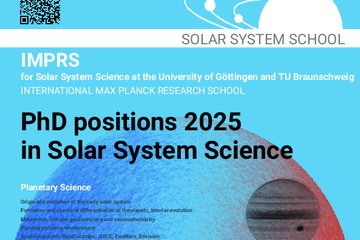All genres
421.
Poster
JUICE: A European Mission to Jupiter and its Icy Moons. DPS 48/EPSC 11, Pasadena, USA (2016)
422.
Poster
Galactic Cosmic Rays access to the upper atmosphere and rings of Saturn. AGU Fall Meeting, San Francisco, USA (2016)
423.
Poster
Dione flybys in the view of energetic particles. DPS 48/EPSC 11, Pasadena, USA (2016)
424.
Poster
Galileo's Energetic Particle Detector: Understanding late mission detector degradation. DPS 48/EPSC 11, Pasadena, USA (2016)
425.
Poster
Energetic environment at Titan's orbit. AGU Fall Meeting, San Francisco, USA (2016)
426.
Poster
The Submillimetre Wave Instrument on JUICE. Ground and space observatories: a joint venture to planetary science, Santiago, Chile (2015)
427.
Poster
Galactic Cosmic Rays tracing in the inner magnetosphere of Saturn. MOP, Atlanta, Georgia, USA (2015)
428.
Poster
Re-evaluating Galileo Energetic Particle Detector data based on radiation detector decay; for use in estimating Sputtering Erosion rates on Europa. European Planetary Science Congress EPSC , Nantes, France (2015)
429.
Poster
Statistical analysis and multi-instrument overview of the quasi-periodic 1-hour pulsations in Saturn's outer magnetosphere. European Planetary Science Congress EPSC , Nantes, France (2015)
430.
Poster
Pickup Ion Signatures in the Vicinity of Titan. AGU Fall Meeting, San Francisco, USA (2015)
431.
Poster
Access of energetic particles to Titans exobase. European Planetary Science Congress EPSC , Nantes, France (2015)
432.
Poster
Hot Plasma Environment Model (HPEM): A empirical model for describing time-dependent processes of the jovian energetic electron environment. European Planetary Science Congress EPSC , Nantes, France (2015)
433.
Poster
Galactic Cosmic Rays impact on Saturn's innermost radiation belt formation. European Planetary Science Congress EPSC, Cascais, Portugal (2014)
434.
Poster
Galactic Cosmic Rays as a source for Saturn Inner Radiation Belt. MAPS workshop, Göttingen, Germany (2014)
435.
Poster
Mapping the flow of energetic particles in Titan's exobase. European Planetary Science Congress EPSC, Cascais, Portugal (2014)
436.
Poster
Tracing of energetic particles in the vicinity of Titan. European Geosciences Union General Assembly, Vienna, Austria (2014)
437.
Poster
Mapping the flow of energetic particles in Titan's exobase. Cassini MAPS workshop, Göttingen, Germany (2014)
438.
Poster
Mapping the flow of energetic particles in Titan's exobase. 10 years of Cassini-Huygens in the Saturnian system, London, UK (2014)
439.
Thesis - PhD
Drei-dimensionale Richtungsverteilungen und relative Häufigkeiten energiereicher Ionen in der Magnetosphäre des Jupiter. Dissertation, Technische Universität Braunschweig (1994)
440.
Working Paper
Galileo/EPD user guide. (2020)











